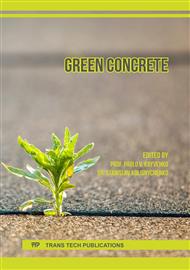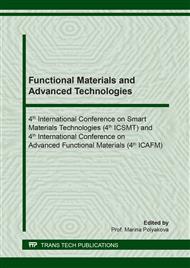[1]
BUCHWALD, A; ZELLMANN, H.-D; KAPS, C.; Condensation of Aluminosilicate Gels: model system for geopolymer binders. Journal of NonCrystalline Solids, v. 357, n. 5, pp.1376-1382, (2011).
DOI: 10.1016/j.jnoncrysol.2010.12.036
Google Scholar
[2]
DAVIDOVITS, Joseph. 30 Years of Successes and Failures in Geopolymer Applications. Market Trends and Potential Breakthroughs. Geopolymer 2002 Conference, pp.1-9. Saint-Quentin, France, (2002).
Google Scholar
[3]
KRIVENKO, Pavel. Alkali-Activated Aluminosilicates: past, present and future. Chemické Listy, v. 102, p. s265-s277, (2008).
Google Scholar
[4]
DUXON, P.; FERNANDEZ-JIMENEZ, A.; PROVIS, J.L.; LUKEY, G.C.; PALOMO, A.; VAN DEVENTER, J.S.J. Geopolymer technology: the current state of the art. Journal of Materials Science, 42:2917-2933. Australia, (2007).
DOI: 10.1007/s10853-006-0637-z
Google Scholar
[5]
DAVIDOVITS, Joseph. From ancient concrete to geopolymers. Arts et Metiers Magazine, n.180, pp.8-16, Saint-Quentin., (1993).
Google Scholar
[6]
DAVIDOVITS, Joseph. Ancient and Modern Concretes: What is the Real Difference. Concrete International, Vol. 9, n. 12, pp.23-35, (1987).
Google Scholar
[7]
LIVI, Carolina Noda. Desenvolvimento de pasta de geopolímeros a base de cinza volante e hidróxido de sódio. Brazil, (2013).
Google Scholar
[8]
SINDICATO NACIONAL DA INDÚSTRIA DO CIMENTO - SNIC. Resultados preliminares. Available on: <http://snic.org.br/numeros-resultados-preliminares-ver.php?id=20>. Access on: 24 July (2018).
Google Scholar
[9]
WORLD BUSINESS COUNCIL FOR SUSTAINABLE DEVELOPMENT – WBCSD. Guidelines for Emissions Monitoring and Reporting in the Cement Industry. Sweden, (2012).
Google Scholar
[10]
WORLD BUSINESS COUNCIL FOR SUSTAINABLE DEVELOPMENT – WBCSD. Global Cement Database on CO₂ and Energy Information. Available on: <https://www.wbcsdcement.org/index.php/key-issues/climate-protection/gnr-database>. Access on: July (2018).
Google Scholar
[11]
DAVIDOVITS, Joseph. Properties of Geopolymer Cements. Geopolymer Institute, Alkaline Cements and Concretes. Ukraine, (1994).
Google Scholar
[12]
BAKHAREV, Tanya. Resistance of Geopolymer Materials to Acid Attack. Cement and Concrete Research, v. 35, pp.658-670. United States, (2005).
DOI: 10.1016/j.cemconres.2004.06.005
Google Scholar
[13]
GIANNOPOULOU, Ioanna; PANIAS, Dimitrios. Structure, Design and Applications of Geopolymeric Materials. Proceedings of the 3rd International Conference on Deformation Processing and Structure of Materials. Serbia, (2007).
Google Scholar



